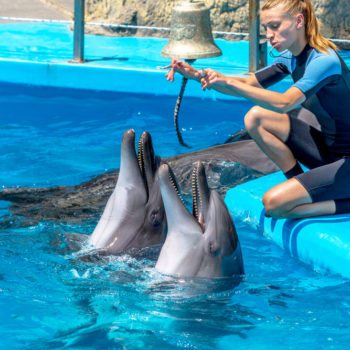Why We Love It
-
$63,800Potential Avg. Salary
-
6.6%Job Growth Rate
-
Growing DemandJob Outlook
-
Dependable Daily WorkloadCareer Attribute
Wildlife conservationists use their time and talents to prevent the extinction of plants and animals. They commonly work for government agencies and develop plans for fostering endangered species, promoting the sustainability of habitats, and rebuilding populations of lifeforms nearing extinction.
Recommended Schools
What is a Wildlife Conservationist?
The following job responsibilities are common for individuals in wildlife conservationist roles:
- Study different species of plants and animals to determine ideal living conditions for these species, and to uncover major dangers to the continuation of the species
- Form plans for rebuilding populations of species that are in danger of extinction
- Develop plans for rebuilding or protecting habitats that are required for species sustainability
- Work with environmental scientists to understand how climate changes may impact different species of plants and animals
- Provide public education on the importance of protecting species, and propose laws against the hunting or destruction of certain species for profit or other human benefit
A Day in the Life
Wildlife conservationists work to prevent the extinction of any form of plant or animal species. They study the different types of plants and animals that are living in ecosystems, and evaluate when population numbers drop to a level that signifies possible extinction. In some cases, wildfires or climate changes can cause impending extinction of different plant and animal species. In other cases, plants and animals near extinction because they’ve been hunted by humans seeking to make a profit.
Wildlife conservationists work for various government agencies and non-profit organizations and evaluate the status of different species. When a species is in danger of population extinction, wildlife conservationists work with law makers to form laws that protect the species, form plans for sustaining endangered populations and promoting population growth, and/or secure funding for protecting and managing lands with habitats that promote the growth and development of endangered species.
In addition to taking legal and proactive measures to protect endangered species, wildlife conservationists also work to educate the public of the importance of avoiding activities that lead to species endangerment. They may form educational campaigns on the importance of preventing forest fires, the importance of leaving animals in their own habitats and not moving them between locations, or the importance of not hunting certain animals for profits.
Typical Work Schedule
For the most part, wildlife conservationists work full-time schedules and have consistent shifts. Overtime may be required occasionally to handle emergencies, but is uncommon.
Typical Employers
Most wildlife conservationists work for agencies of local, state, and federal governments. Others may work for non-profit organizations that provide education or outreach programs.
Recommended Schools
How To Become a Wildlife Conservationist
The first step in becoming a wildlife conservationist is to earn a bachelor’s degree in related field. Common degrees pursued by aspiring wildlife conservationists include environmental science, biology, animal sciences, agricultural science, or wildlife biology. Wildlife conservationists will need a thorough education in plant biology, animal biology, and earth habitats in order to succeed in their roles, so taking coursework in these areas can set you up for success as a wildlife conservationist.
After earning a bachelor’s degree, most wildlife conservationists move on to pursue master’s degrees, and possibly even a Ph.D. While a graduate degree isn’t a requirement for finding work as a wildlife conservationist, higher-level research positions commonly require candidates to hold graduate degrees in the field. For individuals who want to advance beyond entry- and mid-level positions in their careers, earning a graduate degree is recommended.
With the proper degree or degrees, you’ll be prepared to find internships or entry-level work in wildlife conservation. Some people start their careers working in forest management, national parks management, or in zoos. These positions offer aspiring wildlife conservationists an introduction to the habitats, plants, and animals they’ll be working to protect. With professional experience, you’ll be able to move into more senior-level roles working for nonprofits and government agencies, focusing on preventing species endangerment globally.
Wildlife Conservationist Salary Data
We’ve provided you the following to learn more about this career. The salary and growth data on this page comes from recently published Bureau of Labor Statistics data while the recommendations and editorial content are based on our research.
National Anual Salary
Low Range
$47,270Average
$63,800High Range
$91,830National Hourly Wage
Low Range
$23/hrAverage
$31/hrHigh Range
$44/hrHow do Wildlife Conservationist salaries stack up to other jobs across the country? Based on the latest jobs data nationwide, Wildlife Conservationist's can make an average annual salary of $63,800, or $31 per hour. On the lower end, they can make $47,270 or $23 per hour, perhaps when just starting out or based on the state you live in.
Salary Rankings And Facts
#238 Nationally for All Careers
Above Average Salary Nationally
Programs and Degrees
Here are the most common degrees for becoming a Wildlife Conservationist. a is usually recommended and specifically a degree or coursework that prepares you for the particular field, see below.
Highest Education Among Wildlife Conservationists
- 3.9% Doctorate
- 19.1% Masters
- 58% Bachelors
- 8.9% Associates
- 8.7% College
- 0.7% High School
- 0.6% Less than High School
Job Growth Projections and Forecast
2014 Total Jobs
21,1002024 Est. Jobs
22,500Job Growth Rate
6.6%Est. New Jobs
1,400How does Wildlife Conservationist job growth stack up to other jobs across the country? By 2024, there will be a change of 1,400 jobs for a total of 22,500 people employed in the career nationwide. This is a 6.6% change in growth over the next ten years, giving the career a growth rate nationwide of Above Average.
Growth Rankings And Facts
#338 Nationally for All Careers
Above Avg. Growth Nationally
What Companies Employ The Most Wildlife Conservationists
| Industry | Current Jobs | New Jobs Needed | % Increase |
|---|---|---|---|
| Federal government, excluding postal service | 7,200 | -200 | 0% |
| State government, excluding education and hospitals | 5,100 | 400 | 0% |
| Local government, excluding education and hospitals | 3,700 | 400 | 0% |













